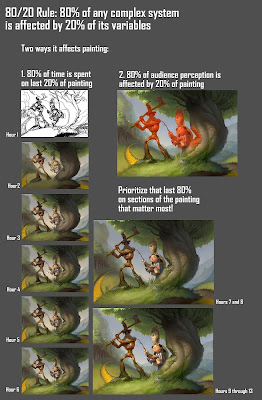I don't always sketch in meetings, but when I do, I sketch strange-looking people.
Friday, February 24, 2012
Monday, February 20, 2012
Teaching fun
One of the pleasures of teaching for Schoolism is that the school brings in people from all over the world and all levels of the art industry. Many of my students are more skilled/talented than I am, and half of them already had impressive jobs in the industry, but took the class because they wanted to fill out one corner of their expertise a bit. I love teaching, and helping anyone learn is rewarding. But it's especially fun when an artist gets exactly what you're trying to say, and pulls off something amazing or unexpected with the limited criteria of an assignment.
Here are some of the highlights from the final assignment of last semester. I gave the students line art and a lot of freedom with the lighting scheme, render style, surfaces, etc.:
 |
| by Dane Madgwick |
 |
| by Colin Foran |
 |
| By Claire Hummel |
 |
| By Stijn Van Doorselaere |
I've also had some impressive students in the self-taught class. I don't get to interact with them as often, but I still enjoy seeing what they do and how they react to the lessons. An artist named Johan Törnlund wrote a thoughtful review (with some criticism also, which is nice because now I can address those problems), here: http://feedchicken.blogspot.com/2012/01/schoolism-review.html
Wednesday, February 15, 2012
The 80/20 Rule
I've often heard artists, designers, management, etc. use "the 80/20 rule" to explain their choices.
"You want 80% to be rest areas and 20% areas of detail"
"80% of this geometry should be interactive and 20% non-interactive"
"As long as we get it 80% right, the extra 20% doesn't matter"
The problem is, none of these things have anything to do with the 80/20 rule. So let's get it right, because this is an important one if you want be a faster artist.
The 80/20 rule states that 80% of a system will be affected by 20% of the variables in it. So that 20% matters a lot. 80/20 doesn't mean that everything divides neatly into that ratio, or that that 80% should be one thing and 20% should be another. Instead, it's a principle of resource allocation.
So as an artist, what is that 20% of your process that takes 80% of your time or resources? There are multiple answers to this question. Here are some ways it applies to me:
How often do you get a painting to the point where it's looking good and you start feeling like you're just about done, only then you spend way more time finishing the painting up than you did getting it to that point? For me, this is true nearly every time. If you paint in detail or care about your brush strokes, this is just a fact of life.
But to make use of the 80/20 rule, you need to do more than identify the problematic 20%. It may be useful for setting proper expectations, but you won't get any faster to know that.
Where the 80/20 rule becomes useful in this case is by applying it in another related area. If I were to uniformly apply detail across this painting once I finished the block-in, it would have taken me three times as long. So instead, once I got to hour 3 or 4, I tried to identify the 20% of the painting that would likely demand 80% of a viewer's attention. Then I focused a disproportionate amount of time and effort developing those areas. The remaining 80% of the painting then fell naturally together in support of the high-attention areas. This is the magic of the 80/20 rule: tackle the correct 20%, and the other 80% often falls into place.
What are some ways that the 80/20 rule could be used to speed up your process?


